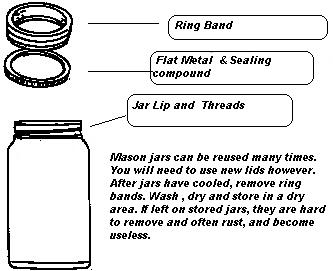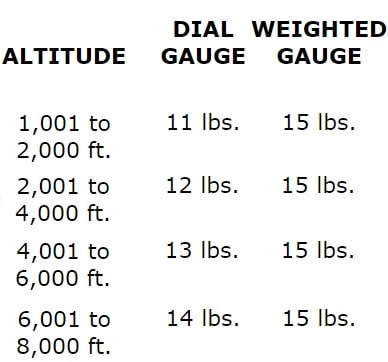Tomatoes can be preserved by canning, drying, freezing, or pickling. They can also be used in creating fruit spreads like jams, jellies and marmalade’s. Raw tomatoes or raw tomato products can be kept refrigerated (below 40 degrees Fahrenheit), but will spoil over time due to bacteria, yeasts, and molds.
Preserving tomatoes in oil is currently not recommended. Oil may protect botulism organisms trapped in a water droplet.
Furthermore, the oil may have a deleterious effect on lid gaskets and at least one manufacturer of home canning lids recommends against it.” National Center for Home Food Preservation
“Only boiling water or pressure canning methods are recommended for canning foods. Methods, such as oven canning and open-kettle canning, have been discredited and can be hazardous”
When canning tomato products it is important to measure and follow recipes accurately. For example, the spaghetti sauce recipe calls for 30 pounds of tomatoes and 1 cup of green pepper. The proportions of tomatoes, which are acidic, should not be decreased.
Green peppers are a low acid food and their ratio in many instances cannot be increased , however low acid foods may be decreased or omitted.
Select disease-free, vine ripened, firm fruit for canning.
Do not can tomatoes from dead vines or that appear bruised or defective in any way.
To ensure safe acidity in whole, crushed, or juiced tomatoes, add two tablespoons of bottled lemon juice or a teaspoon of citric acid per quart of tomatoes. For pints, use one tablespoon of bottled lemon juice or a teaspoon of citric acid.
Acid can be added directly to the jars before filling with the product. Add sugar to offset acid taste, if desired. One to two teaspoons of sugar may be enough to enhance the flavor.
What Types of Jars to Use for Canning Tomatoes?

Mason Jars are recommended for home canning. Be sure all jars and closures are perfect. Discard any that have cracks, chips, dents, rust, as such defects prevent airtight seals.
Wash the jars in hot, soapy water and rinse well before using. Prepare metal lids as per the manufacturer’s instructions.
After jars are filled , remove any trapped air bubbles, adjust the head space, and clean the jar tops .
To remove trapped air bubbles, insert a nonmetallic spatula or knife between the food and the jar. Slowly turn the jar and move the spatula up and down to allow air bubbles to escape. Add more liquid if necessary to obtain the proper head-space.
The jars are now ready to process in a pressure canner. Process according to the Manufacturers specifications.
After processing, remove the jars from canner carefully and place on rack or dry towel. Allow the jars to cool for a full day, away from drafts.
Test the Jar Seals
Press the flat metal lids near the center . It shouldn’t move and should be slightly concave.
Label sealed jars with its contents, and date of canning . Store in a clean, cool, dry, dark place.
Related: How to Grow Tomatoes
Ways to Can Tomatoes
1. How to Can Tomatoes Using a Pressure Canner
The manufacturer’s instructions for the safe operation of their pressure canner supersedes any other instruction other than the USDA.
Add two tablespoons of bottled lemon juice or a teaspoon of citric acid per quart of tomatoes. For pints, use one tablespoon of bottled lemon juice or a teaspoon of citric acid.
The use of a pressure canner generally results in higher-quality and more nutritious canned tomato products. If your pressure canner cannot be operated above 15 PSI, select a processing time at a lower pressure.
Altitude Adjustments: Most processing pressures given for canning tomatoes and tomato products are for an altitude of 0 to 1000 feet. If you are canning at a higher altitude see the accompanying Chart.

Select fresh, firm, disease-free, vine-ripened ripe tomatoes, not can soft or overripe ones. Green tomatoes are much more acidic than ripe tomatoes and can also be canned safely.
2. How to Can Tomatoes Using the Boiling Water Bath
A Water bath canner is a deep kettle with a wire insert that holds your canning jars. It’s used to preserve foods high in acids, such as tomatoes, fruits, and berries.
To process food in a boiling water canner, fill the canner halfway with water and preheat to 180 F for hot packs or 140 F for raw packs.
Load sealed jars into the canner rack [Jar rack] and lower with handles or load one jar at a time with a jar lifter onto rack in canner.
Cover canner and turn heat to high. Add water if needed to a level of 1 inch above jars.
Do not add Cold Water to already boiling water, keep an extra kettle of water on the stove burner in case extra boiling water is needed to cover the jars in the canner. When water boils vigorously, lower the heat to maintain a gentle boil and process for the time given in manufacturers instructions.
Related: Why Do Tomatoes Split?
3. Low-temperature Pasteurization Treatment
Place jars in a canner filled halfway with warm (120 F to 140 F) water. Add hot water to a level 1 inch above jars. Heat the water and maintain 180 F water temperature for 30 minutes.
Use a candy or jelly thermometer to be certain that the water temperature is at least 180 F during the entire 30 minutes. Temperatures higher than 185 F may cause unnecessary softening.
This treatment results in a better texture but must be carefully managed to avoid possible spoilage. You should use this method only when the recipe indicates.
Types of Pressure Canners for Canning Tomatoes
There are two types of pressure canners. The main difference is the way they measure pressure. One uses a dial gauge and the other uses a weight system to control the amount of pressure build-up.
Processing times vary for either style.
See: Using Pressure Canners from the National Center for Home Food Preservation
How to Dry Tomatoes
Use only the best quality Tomatoes.
Choose tomatoes that are ripe, un-bruised and at peak-eating quality.
Prepare foods to be dehydrated as you want them to be served. Apples, for example, may be sliced, cut into rings, or pureed for fruit leather.
Keep pieces uniform in size and thickness for even drying . Slices cut 1/8 to 1/4-inch in thickness will dry more quickly than thicker pieces.
Some foods should be washed before drying. Foods such as herbs, berries and seedless grapes need only be washed before dehydrating.
To prevent browning: try steaming, sulfuring, or coating light-colored fruits and vegetables with acids such as lemon juice or ascorbic acid before drying.
Steaming or blanching also is recommended for vegetables to inactivate enzymes that cause vegetables to mature or toughen during drying
See Also: Sun Dried Tomatoes

